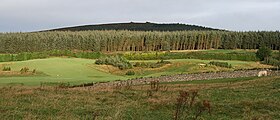Two Rock
| Two Rock Mountain (Binn Dá Charraig) | |
|---|---|
| Black Mountain; Sliab Lecga | |

Two Rock from the south
|
|
| Highest point | |
| Elevation | 536 m (1,759 ft) |
| Prominence | 171 m (561 ft) |
| Listing | Marilyn (hill) |
| Coordinates | 53°14′10″N 6°14′30″W / 53.236194°N 6.241557°WCoordinates: 53°14′10″N 6°14′30″W / 53.236194°N 6.241557°W |
| Geography | |
| Location | Dún Laoghaire–Rathdown, Ireland |
| Parent range | Dublin Mountains |
| OSI/OSNI grid | O1721922374 |
| Topo map | OSi Discovery Series No. 50 |
Two Rock (Irish: Binn Dá Charraig;archaic: Black Mountain;Sliab Lecga (meaning Mountain of Flagstones)) is a mountain in Dún Laoghaire–Rathdown, Ireland. It is 536 metres (1,759 feet) high and is the 382nd highest mountain in Ireland. It is the highest point of the group of hills in the Dublin Mountains which comprises Two Rock, Three Rock, Kilmashogue and Tibradden Mountains. The mountain takes its name from the two granite tors that lie to the south-east of the summit. From the summit, which is called Fairy Castle, there are views of much of the Dublin area from Tallaght to Howth to the north while Bray Head, Killiney Hill, the Great Sugar Loaf and the Wicklow Mountains are visible to the south. The summit area is mostly shallow bog while ferns and gorse cover the lower slopes. The mountain is also an important habitat for red grouse.
A number of prehistoric monuments can be found on the mountain including a passage tomb on the summit and a wedge tomb on the slopes near Ballyedmonduff.
Fairy Castle, as the summit is known, is marked by a stone cairn and an Ordnance Survey trig pillar. These both sit on top of a circular structure of granite and quartz blocks 25 metres (82 feet) across and 2 metres (6.6 feet) high and covered by turf and vegetation. This is the remains of a passage tomb, the easternmost of a series of such tombs that stretches across the Dublin and West Wicklow Mountains. The entrance to the tomb – once described by locals as a “cave” – can no longer be seen due to the collapse of the edges of the cairn. There is no evidence that the tomb has ever been opened but archaeologists believe that the interior contains a small burial chamber.
...
Wikipedia

